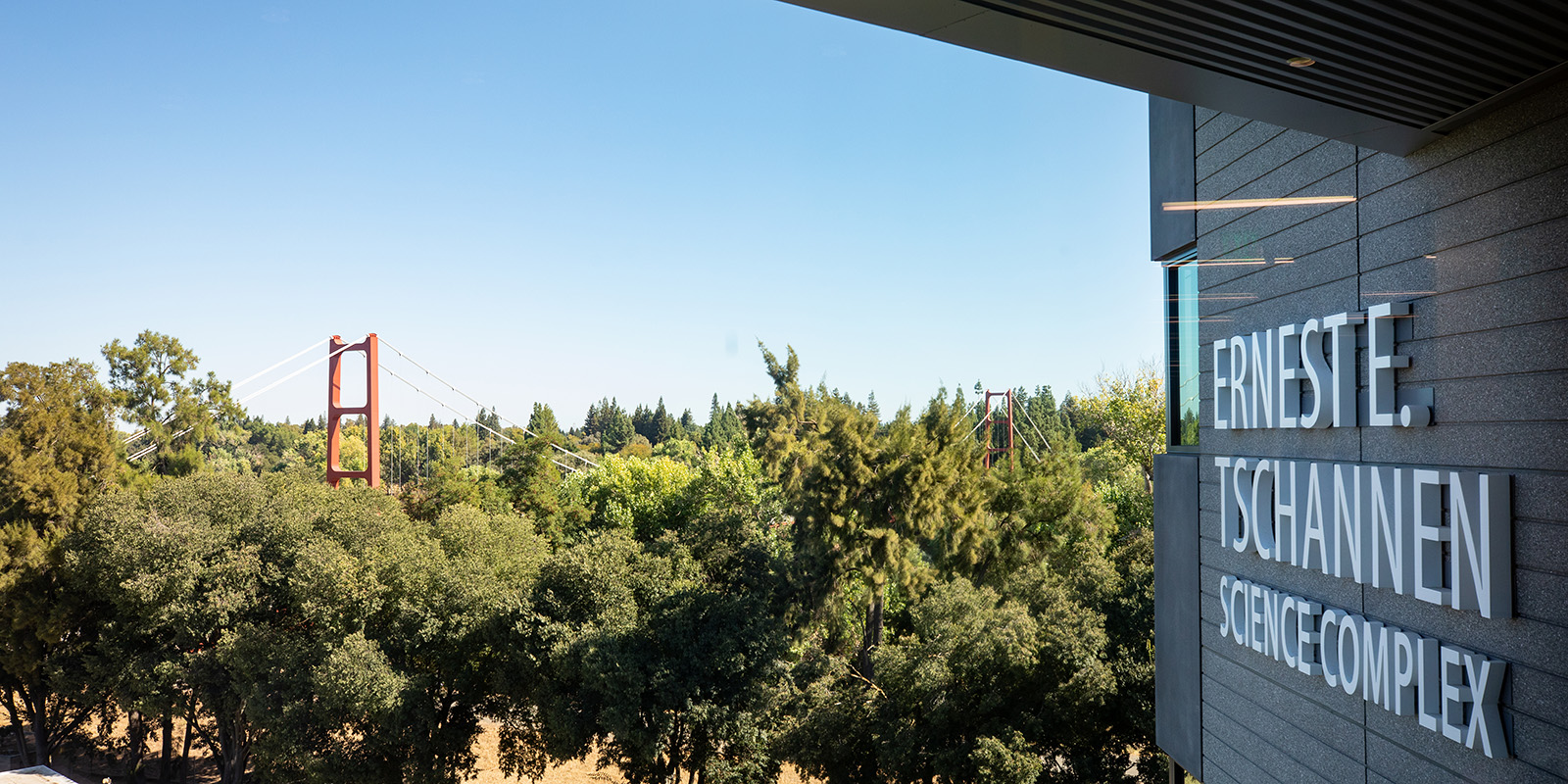

Excellence Is Intentional
at Sac State’s new centerpiece
Dixie Reid
“Throughout the building are gestures, both subtle and grand, that provide opportunities for discovery”
The Ernest E. Tschannen Science Complex is a striking piece of architecture, a commanding presence near the American River with an already-popular zinc-domed Planetarium tucked in at the crook formed where about half of the building angles off from the other.
Physically imposing, the complex already is a Sacramento State landmark, a site that will provide education and opportunities for a significant portion of the University’s students now and into the future. It is expected to be a beacon for the community at large.
Inside and out are elements of thoughtful, intentional design that make the complex not only attractive and arresting, but also a hub for cooperative, collaborative learning – state of the art physically and intellectually
That intentional design resulted in a unique complex that earned the distinction of being named the most energy-efficient science building in the 23-campus California State University (CSU) system.
It was built to meet stringent standards for LEED Gold certification, making it healthier and better for the environment than traditional construction projects.
Sustainability is its watchword. Nearly 20 percent of building products used in construction were made from recycled materials, and in turn, more than 75 percent of the construction waste was recycled.
Felled campus trees got new life as decorative interior walls and outdoor benches. The grassy roof terrace thrives on captured stormwater. “Smart” lighting reduces electrical usage.
“And throughout the building are gestures, both subtle and grand, that provide opportunities for discovery,” project manager Tania Nunez says. “These opportunities set the building apart from others on campus and across the CSU, giving you the ability to find your own special spot that resonates with your Sacramento State experience.”
Outside the main building are the plaza, with its vast expanse of drought-tolerant plants, and the 120-seat Planetarium, which delights Sac State students and campus visitors – area schoolchildren were immediately smitten – with immersive, virtual trips to faraway galaxies.
The Science Complex was named for Ernest E. Tschannen, a local real estate entrepreneur whose $9 million donation toward construction was the largest single gift in Sacramento State’s history. The CSU committed $71 million to build the complex, and Sac State is raising an additional $20 million through private donations and naming opportunities.
The University teamed with CO Architects and Sundt Construction on a design-build partnership that delivered the Science Complex on time and on budget.
“The collaboration resulted in a superior project that will set the standard for science facilities across the CSU,” Nunez says.
“Having the design-build team work directly with faculty and staff in the College of Natural Sciences and Mathematics ensured that the spaces were thoughtfully and efficiently designed to meet critical needs and functions.”
The main thrust, though, is what the Science Complex promises students and portends for the greater community: exciting opportunities for learning and research; and more well-trained young people taking their knowledge and excellence into a world that needs their expertise and embraces their accomplishment.
Stronger Together
All signs in airy new Science Complex point to collaboration
By Cynthia Hubert
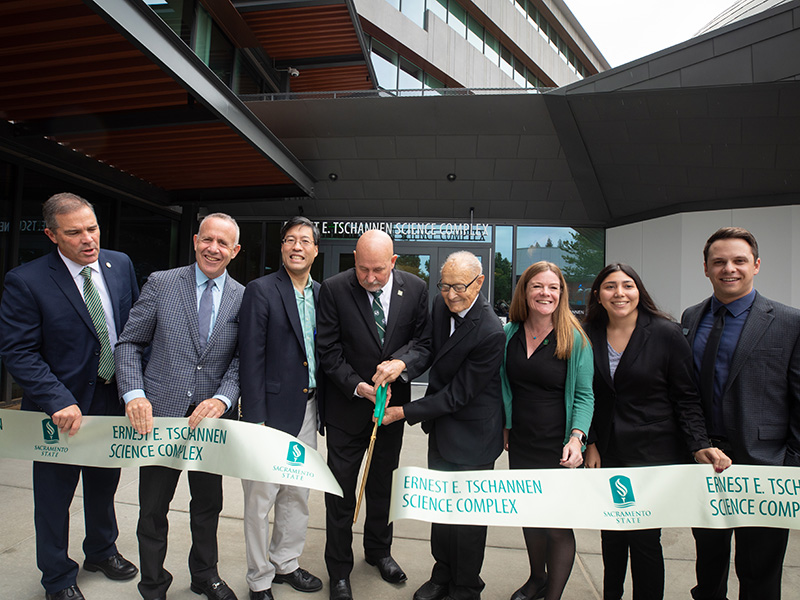 From their laboratory on the fourth floor of the new Ernest E. Tschannen Science Complex, Professor Rob Crawford and his students can look through glass panels and see another group of young scientists in action in a room across the hall.
From their laboratory on the fourth floor of the new Ernest E. Tschannen Science Complex, Professor Rob Crawford and his students can look through glass panels and see another group of young scientists in action in a room across the hall.
Common areas on each floor near the elevator provide places where they can perch on raised seats and read or work on their laptops as a wall of windows offers views of the Guy West Bridge and the American River, as well as other scenes of the tree-covered campus.
On each of the building’s five floors, a casual and inviting “collaboration area” offers living room-like space with open seating where people can chat, study, or eat lunch – or just relax.
The Science Complex opening (shown above, with President Robert S. Nelsen and philanthropist Ernest E. Tschannen holding the scissors) that coincided with the start of the Fall 2019 semester presents “a whole new world” for students, faculty, and staff, says Crawford, a Biology professor.
“We have a generation of students and faculty who worked in the basement” at nearby Sequoia Hall, he continues, referring to the antiquated facility that preceded the Science Complex.
“Now we have this beautiful space, new equipment, a gorgeous learning environment. We’re going to do some great science here.”
Aesthetics were an important consideration in the design and construction of the building, says project manager Tania Nunez. The complex is bright and open, with large windows that bring in natural light and capitalize on “amazing views,” she says. Interior colors – reds, grays, and browns – tie spaces together. Large, artful wooden numbers that identify each floor were crafted from campus trees that were felled as a safety measure a few years ago.
“We want you to walk into these spaces and feel like you’re not in a dungeon, that you’re somewhere that you want to be,” Nunez says.
But the building is about much more than its good looks, she continued. It is a showcase for 21st century science education. It is a monument to collaborative teaching and learning, an approach that encourages students to work with one another to solve problems and complete tasks. It is based on the idea that learning is a naturally social process that works best when students talk among themselves and with their professors.
“It piques curiosity, and curiosity is the first step if you’re interested in studying science,” says graduate student Angelina Tupikova. “This building is doing that for us.”
Students are encouraged to actively engage with their peers, rather than simply memorize and regurgitate information from textbooks. The approach encourages listening to different perspectives and defending positions. Lively discussion of course material is emphasized as a valuable addition to lectures and note-taking.
“Instead of being talked at by their professors, they’re learning by engagement,” Crawford says. “It’s a much more interactive learning experience.”
The new building has traditional labs with sleek gray countertops and gas, air, and nitrogen dispensers within reach. It offers small conveniences such as cubby holes to store backpacks, and outside shelves to stash drink cups and water bottles.
Those conveniences allow students to focus on studies, Nunez says. But the open design is the building’s hallmark.
It features large “learning studios” and undesignated resting places that encourage interaction. Glass panels that separate labs from hallways double as writing surfaces on which professors can scrawl chemical equations and assignments while allowing passersby glimpses of the learning process.
Classroom spaces mimic laboratories where students will conduct research in the working world after they graduate.
“By putting them into these classrooms, we’re preparing them for the next steps,” Crawford says.
A second analytical chemistry lab in the new building is helping ease overcrowding, allowing more students to enroll in classes they need and go on to a timely graduation.
Science Complex features meant to “enhance student learning,” Nunez says, resulted from numerous meetings with faculty members to identify “exactly what they would need” to achieve that goal.
“We wanted to give professors everything they need to teach effectively, and by and large, the reactions have been very positive,” she says.
Almost immediately after teaching his first classes inside the new facility, Professor Drew Reams noticed a new level of enthusiasm among his students.
“I love it,” Reams says one afternoon after wrapping up an advanced molecular biology class.
“It’s very modern. I feel like we’re adapting and evolving,” Reams says. “I like that everything is so new. The equipment is just great. It’s like they built this big, amazing spaceship and we have been given the keys to fly into space.”
The new design fosters natural interactions “because there are no walls to separate us,” Reams says. “I can already tell that students are more excited and engaged.”
Biochemistry major Sarai Ontiveros soaked in the building’s ambience between classes on an early September morning.
“It’s pretty cool,” Ontiveros says, sitting at a table overlooking the Planetarium, a Science Complex centerpiece. “I like the views, and it feels a lot more open. I’m seeing a lot more people just having conversations about science.”
Graduate students Chloe Welch and Heather Larson took a break from their microscopic look at fruit flies and study of neurodevelopmental disorders to consider their new laboratory digs, praising its thoughtful touches.
“We all had our little spaces before, so it was harder to communicate,” Welch says. “We’re working physically closer to people who are studying the same things. It makes sense.”
Graduate student Tupikova says she was pleased to be among the first young scientists to work inside the facility. “I find it very uplifting,” she says, adding that the environment “encourages us to bounce ideas off one another” and share knowledge.
The Science Complex, Crawford predicts, will be an important tool for attracting to Sacramento State the best and brightest students and faculty.
“We all feel really fortunate to move into a state-of-the-art space, one that truly promotes education and research,” he says. “I feel so lucky to be here at this time in my career. I couldn’t be more excited.”
Science Complex Breakdown
Just a few of the unique features of this new facility
By Dixie Reid
Taken in as one big view, the Ernest E. Tschannen Science Complex is an impressive sight. But separate looks at individual components of the $91 million complex reveal a collection of innovations and creative touches that elevate the entire project from the mundane to the truly special. Here are a few examples.
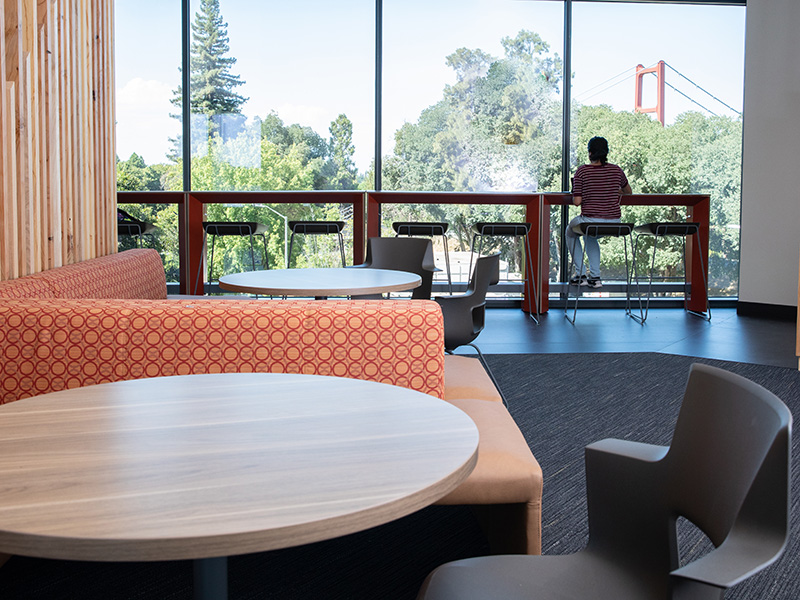 Kick back
Kick back
Students using the casual and comfortable open study spaces can look up from their work and see the sky, the campus tree canopy, the Guy West Bridge, or catch a glimpse of the American River running beneath the H Street Bridge. This is the first academic building on campus with clear river views.
Get a good look
Teaching and research are on display in the Science Complex, apparent when one looks through the vast expanses of glass separating corridors from labs. And professors who write on the opaque “marker” walls – the modern version of a chalkboard – are giving passersby a view of research and calculations as they happen.
A smaller sip
Drought-tolerant and native plants fill the garden, reducing the need for irrigation by 50 percent over traditional landscaping. The planting design was intentional, mimicking the familiar quilt-like patterns of Central Valley farmland. The complex’s living roof is attractive and helps insulate the building and control storm-water runoff.
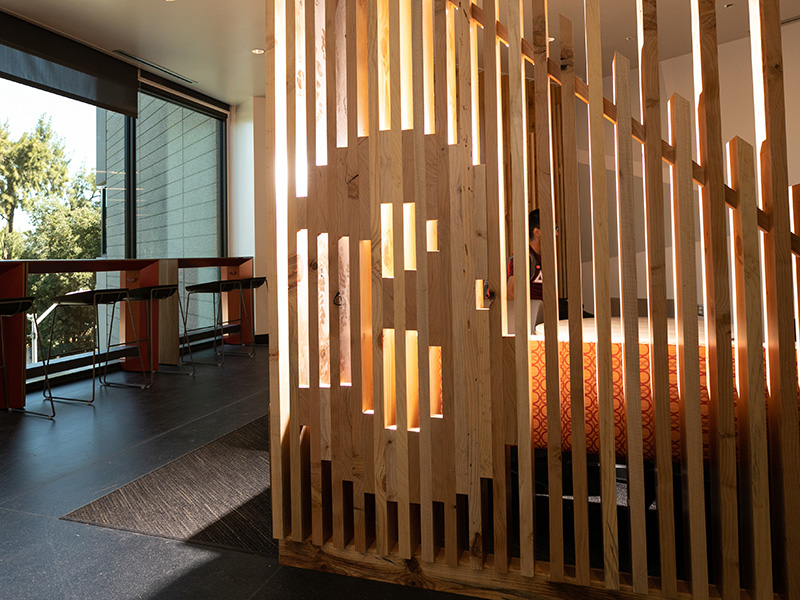 Immortal wood
Immortal wood
Sac State partnered with the Sacramento Tree Foundation and its Urban Wood Rescue program to reuse more than 50 felled campus trees, milling them into outdoor benches and feature walls for the building’s lobby and study areas. Salvaged lumber also became unique floor-number signage outside the elevators.
Safety first
The Introductory Chemistry Lab’s fume hoods might resemble cartoony alien creatures, but built-in sensors and variable fans supply air when needed. Hallway cabinets hold students’ lunch bags and water bottles while they’re in lab classes, and all labs contain emergency showers and eye-wash stations, meeting all safety standards.
Compelling climb
The lobby staircase, with its showy “rings of Saturn” chandelier, is meant to entice students, faculty, and staff to take the stairs to and from the second floor, rather than using the elevator. It’s a compelling and healthy alternative.
Soaring shows at new Planetarium remain a hot ticket
By Cynthia Hubert
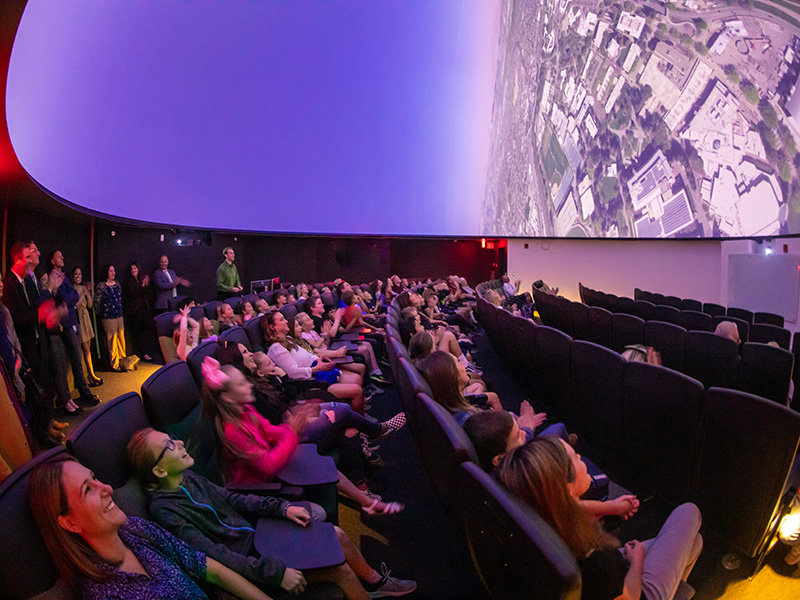
Shows at the Sacramento State Planetarium, a centerpiece of the new Ernest E. Tschannen Science Complex, are among the hottest tickets in town.
The Planetarium’s seven inaugural shows in late September all sold out shortly after tickets became available. Subsequent public shows received similar response.
Student field trips are proving equally popular. The Planetarium is hosting schoolchildren mornings and afternoons five days a week during the fall, and most slots have filled quickly. School visits can be arranged through the Planetarium’s page on Sac State’s website.
The first student visitors, seventh- and eighth-graders from Natomas Charter School, oohed, aaahed, and gasped as Planetarium Director Kyle Watters took them on a tour of the solar system and discussed the orbits of planets.
“That’s so cool!” one of the young visitors gushed as Watters zoomed in on Saturn.
The Planetarium features a dome 40 feet in diameter that offers a 360-degree viewing experience. Super-high-definition tours of the solar system put viewers in the midst of the action and seem so real that they can spur motion sickness, Watters warned.
Besides astronomy presentations, future shows might feature geological and historical expeditions.
The Planetarium’s opening generated a major buzz on campus, said Laura Lege, a Physics and Astronomy lecturer.
Until now, instructors relied heavily on props such as globes and spheres to illustrate the alignment of planets, Lege said.
“Now,” she said, “we can push a button and you’re there.”
The Planetarium has three missions, Watters said, serving as a lecture hall for introductory astronomy courses; a venue for school field trips; and a destination for the public at large.
Field trips for students from kindergarten through high school, so far free to those students, have filled the facility.
Congresswoman Doris Matsui, who helped secure federal funding for the Science Complex, recently toured the building and then greeted elementary school students visiting the Planetarium.
“You are very, very lucky, because there is nothing like this Planetarium anywhere,” she told Placer Elementary School fifth-graders.
Multiple public shows, mostly selling out shortly after they are announced, are being offered one weekend each month. The cost is $5 for adults. Shows are hosted by faculty from the Department of Physics and Astronomy.
Opportunities remain to provide financial support for the Planetarium, including for the building itself, for which the University seeks a $5 million donor. Donors who contribute $1,000 get their name on a plate permanently affixed to the back of one of the Planetarium’s 120 seats.
Reservations for shows can be made through the Hornet Ticket Office.
